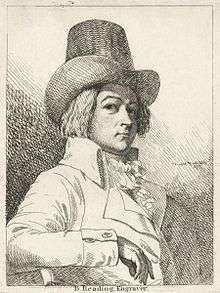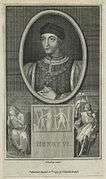Burnet Reading

Burnet Reading (1749–1838) was an English engraver and draughtsman.[1]
Biography
Reading was a native of Colchester, and practised in London. He worked entirely for the booksellers, engraving chiefly portraits of contemporary celebrities, many of which appeared in Bell's "British Theatre," 1776–86, and the "European Magazine," 1783–93. Reading engraved a set of six portraits of members of the Royal Academy, from drawings by Peter Falconet and another of members of the American Congress, 1783; also some of the plates to Boydell's "Shakespeare," and a few fancy subjects, such as "Lavinia and her Mother," after W. Bigg, and "Charlotte at the Tomb of Werther," from his own design. In 1820 a set of twelve etchings by Reading, from drawings by Mortimer, of "Characters to illustrate Shakespeare," was published by T. and H. Rodd; and many of the plates in that firm's "Collection of Portraits to illustrate Granger's “History of England,”" 1820 and 1822, were engraved by him. He was employed as drawing and riding master by the Earl of Pomfret at Windsor. A portrait of Reading was etched by Samuel De Wilde in 1798.
Gallery
References
- ↑ "Burnet Reading". npg.org.uk. Archived from the original on March 17, 2015. Retrieved March 17, 2015.
- Attribution
![]() This article incorporates text from a publication now in the public domain: O'Donoghue, Freeman Marius (1896). "Reading, Burnet". In Lee, Sidney. Dictionary of National Biography. 47. London: Smith, Elder & Co.
This article incorporates text from a publication now in the public domain: O'Donoghue, Freeman Marius (1896). "Reading, Burnet". In Lee, Sidney. Dictionary of National Biography. 47. London: Smith, Elder & Co.
External links
![]() Media related to Burnet Reading at Wikimedia Commons
Media related to Burnet Reading at Wikimedia Commons



.jpg)
